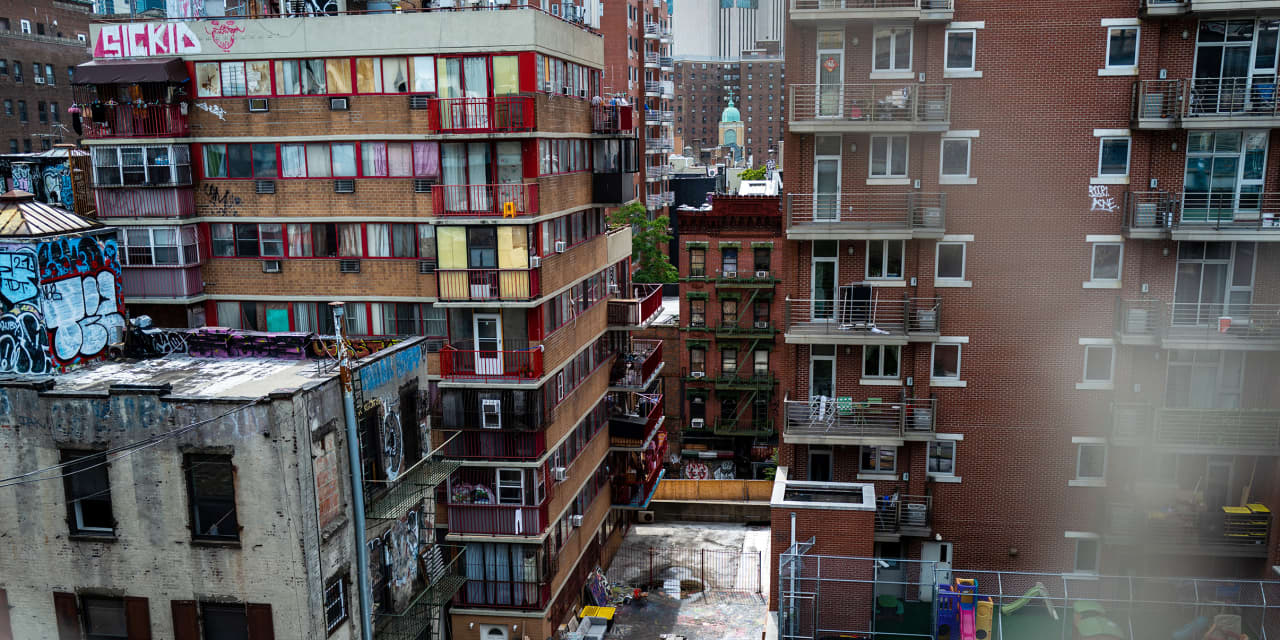New York Community Bank has long been the leading lender for rent-regulated apartments in New York City and that portfolio could get increasing scrutiny from investors due to financial pressures on landlords.
New York Community Bancorp
surprised Wall Street Wednesday when it reported a loss of $260 million, or 36 cents a share, in the fourth quarter as it added $552 million to its loan-loss provisions mostly related to real estate loans. It also slashed its quarterly dividend to five cents a share from 17 cents. The company’s stock skidded 37% to $6.53. Shares are down another 7.9% to $5.96 Thursday as fear spread to other banks.
The added reserves reflected weakness in the office sector and what the company referred to as “loan repricing risk” in the multifamily loan book, an apparent reference to the impact of higher loan rates on borrowers. The bank’s New York rent-regulated portfolio totaled $18.3 billion at the end of 2023, or about half its multifamily loan book. The bank had total loans of $84 billion.
New York Community Bancorp’s rent-regulated portfolio concentrated in New York City historically has had pristine credit quality with minimal losses. But that could change as landlords of rent-regulated, nonluxury apartments face strains from higher expenses for insurance, maintenance, and other costs. They face strict rules on rent increases that tenant-friendly New York City imposes on landlords of about a million rent-stabilized apartments.
These are not the free-market luxury apartments in Manhattan and popular areas of Brooklyn that rent for $4,000 or more a month.
The average rent on stabilized apartments is artificially maintained at below-market levels—about $1,300 a month outside Manhattan in places like the Bronx, Queens, and Brooklyn and $1,500 in Manhattan. Rents are kept low to provide what advocates say is “affordable housing” to financially pressed working people, even though many affluent New Yorkers live in rent-stabilized apartments.
Rent increases are limited annually—3% for one-year leases in the latest year—and landlords have complained of increasing financial pressures amid higher costs to maintain older buildings that were constructed from the late 1940s through early 1970s.
Landlords have a difficult time recouping capital expenditures via higher rents and tenants often pass down low-rent apartments to children to keep them in the family under lenient city laws.
“New York City stabilized buildings are facing an insolvency crisis as a result of factors, each impactful on their own, but when taken together, as they are now, are devastating,” Michael Tobman, the membership and communications director for landlord group Rent Stabilization Association, said last year.
He told Barron’s in a statement that “stress on regional and community banks is directly linked to government policies that have devalued multifamily buildings.”
New York Community Bank gave considerable detail on the New York rent-regulated portfolio in its financial report Thursday. The $18 billion portfolio has an average loan-to-value ratio of 58%, which is favorable since it suggests that the bank has a nice cushion to absorb any losses on the roughly 3,000 loans. The average coupon interest rate also is low at 3.85%.
The percentage of nonperforming loans is just 0.52% but “criticized” loans, which have some adverse issues, make up 14% of that portfolio.
The riskiest part of that portfolio is probably the $5.1 billion of loans backed by buildings whose apartments are wholly rent-regulated since they face the most restrictions on rent increases. Other parts of the $18 billion portfolio have varying percentages of rent-regulated apartments.
The 100% rent-regulated portfolio has an average loan balance of $4.9 million and non-performers are just 1% of the loan book.
Overall, criticized loans in the bank’s $37 billion multifamily portfolio were up $1.4 billion to $3.1 billion in the quarter, or 8.3% of the portfolio, the bank said in its slide presentation accompanying the earnings report.
On the conference call Thursday, the bank’s chief financial officer John Pinto said he was “very comfortable” with the quality of the multifamily loan book. The bank has considerable experience in the sector having been a major lender to New York multifamily landlords for five decades.
One potentially worrisome sign about New York commercial real estate was the sale by the FDIC in late 2023 of $16.8 billion of loans from the failed
Signature Bank
that included New York commercial real estate loans. Those loans sold for 71 cents on the dollar.
After the sale, Wedbush analyst David Chiaverini wrote in a client note that the sale was a “negative read-through” for New York Community Bank because he thought that FDIC portfolio had “similar characteristics’ to the bank’s loan book.
He wrote that the FDIC portfolio didn’t contain rent-regulated properties which he argued “likely have a lower implied valuation” due to “pressure on rent-regulated NOI,” or net operating income.
In a client note Wednesday, Chiaverini reiterated an Underperform rating on the stock and cut his 2024 and 2025 core earnings per share estimates to 65 cents and 75 cents respectively, from $1.35 and $1.55 a share. He cited the bank’s “above average” commercial real estate exposure.
New York Community Bank did not immediately respond to a request for comment.
Write to Andrew Bary at [email protected]
Read the full article here







